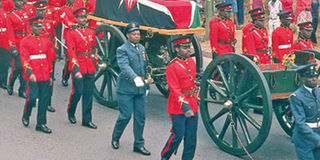Moi funeral may be a replica of Mzee’s in 1978

The funeral procession for the late President Mzee Jomo Kenyatta on August 31, 1978. PHOTO | FILE | NMG
What you need to know:
The funeral will include pallbearers from the military, a number of gun salutes, renditions from KDF bands and choirs and chaplains chosen from the military and the religious groups.
There is, however, a question of where Moi will be buried. During the burial of his wife, Lena, in 2004, Moi expressed his wish to be buried next to her in Kabarak “when my time comes”.
President Uhuru Kenyatta’s proclamation that former President Daniel arap Moi is to be buried in full civilian and military honours has set in motion elaborate and complex procedures whose end will be a grand ceremony that will be witnessed for the second time in Kenya.
“As an expression of public sorrow the flag of ... Kenya shall be flown at half-mast at State House, State Lodges, public buildings and grounds, military bases, posts and stations and naval vessels until sunset on the day of the burial,” the President said.
As a former Head of State, Mr Moi is to receive a State funeral. The proclamation by Mr Kenyatta was just the first of many honours the country will bestow on Mr Moi.
As elaborate as they are rare, State funerals observe strict rules of protocol.
Only a sitting President can proclaim a State funeral, which involves a period of national mourning.
“In testimony of the respect in which the memory of ... Daniel Toroitich arap Moi is held, the nation will observe a period of national mourning from today,” Mr Kenyatta said.
Moi’s will be the sixth State funeral, but only the second to have full military honours. The only other person to be treated thus was founding President Jomo Kenyatta in 1978.
Former Vice-President Kijana Wamalwa, Nobel Peace laureate Wangari Maathai, former Nyeri Governor Wahome Gakuru and former First Lady Lucy Kibaki were given State funerals minus the military element.
Like happened in 1978 when President Kenyatta died, the military took over operations at Lee Funeral Home, Nairobi, immediately it was announced that Moi had died.
A meeting of high-ranking State and Kenya Defence Forces (KDF) officials was convened with Interior Cabinet Secretary Fred Matiang’i as chairman. It was announced that Head of Public Service Joseph Kinyua would chair the State funeral committee.
As that happened, 10 officers from the military police took position in two lines leaving a path between them on the steps of the funeral home. Two others stood on the doorway.
The standing on guard is a sign of respect for the former commander-in-chief’s service to the military. Moi was president for 24 years.
If the 1978 script is followed, military officers will continue standing in that position until the body is moved to another location to lie in state.
Mzee Kenyatta’s body lay in state for 10 days and national mourning lasted a month. During that time, it was guarded by 16 officers at any given time.
After the viewing period, the body was wheeled to Parliament on a horse-drawn carriage through the streets of Nairobi to his final resting place at Parliament grounds.
It was escorted by soldiers, government officials and mourners. The coffin was draped with the Kenyan flag and a coat of arms affixed on the carriage.
Moi’s burial plans will be made public soon.
The funeral will include pallbearers from the military, a number of gun salutes, renditions from KDF bands and choirs and chaplains chosen from the military and religious groups.
There is, however, a question of where Moi will be buried. During the burial of his wife, Lena, in 2004, Mr Moi expressed his wish to be buried next to her in Kabarak “when my time comes”.
In a previous interview with the Nation, former Attorney-General Charles Njonjo said that while some members of Mzee Kenyatta’s family wanted him buried in Gatundu, they were informed that the President “was bigger than his constituency in Central Province”.
“We felt that he should be buried in a Parliament that he created,” Mr Njonjo said, adding that this reflected Mzee’s national stature.





